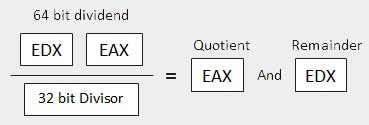Arithmetic
INC & DEC
INC EBX ; Adds 1 to EBX
DEC EBX ; Subtracts 1 from EBX
ADD & SUB
ADD ebx, ecx ; add ecx to ebx, storing the results in ebx
SUB ebx, ecx ; subtract ecx from ebx, storing the results in ebx
MUL/IMUL
There are two instructions for multiplying binary data. The MUL (Multiply) instruction handles unsigned data and the IMUL (Integer Multiply) handles signed data. Both instructions affect the Carry and Overflow flag.
Syntax The syntax for the MUL/IMUL instructions is as follows −
MUL/IMUL multiplier
Multiplicand in both cases will be in an accumulator, depending upon the size of the multiplicand and the multiplier and the generated product is also stored in two registers depending upon the size of the operands. Following section explains MUL instructions with three different cases −
| Sr.No. | Scenarios |
|---|---|
| 1 | When two bytes are multiplied − The multiplicand is in the AL register, and the multiplier is a byte in the memory or in another register. The product is in AX. High-order 8 bits of the product is stored in AH and the low-order 8 bits are stored in AL.  |
| 2 | When two one-word values are multiplied − The multiplicand should be in the AX register, and the multiplier is a word in memory or another register. For example, for an instruction like MUL DX, you must store the multiplier in DX and the multiplicand in AX. The resultant product is a doubleword, which will need two registers. The high-order (leftmost) portion gets stored in DX and the lower-order (rightmost) portion gets stored in AX.  |
| 3 | When two doubleword values are multiplied − When two doubleword values are multiplied, the multiplicand should be in EAX and the multiplier is a doubleword value stored in memory or in another register. The product generated is stored in the EDX:EAX registers, i.e., the high order 32 bits gets stored in the EDX register and the low order 32-bits are stored in the EAX register.  |
Example
The following example multiplies 3 with 2, and displays the result −
section .text
global _start ;must be declared for using gcc
_start: ;tell linker entry point
mov al,'3'
sub al, '0'
mov bl, '2'
sub bl, '0'
mul bl
add al, '0'
mov [res], al
mov ecx,msg
mov edx, len
mov ebx,1 ;file descriptor (stdout)
mov eax,4 ;system call number (sys_write)
int 0x80 ;call kernel
mov ecx,res
mov edx, 1
mov ebx,1 ;file descriptor (stdout)
mov eax,4 ;system call number (sys_write)
int 0x80 ;call kernel
mov eax,1 ;system call number (sys_exit)
int 0x80 ;call kernel
section .data
msg db "The result is:", 0xA,0xD
len equ $- msg
segment .bss
res resb 1
DIV/IDIV
The division operation generates two elements - a quotient and a remainder. In case of multiplication, overflow does not occur because double-length registers are used to keep the product. However, in case of division, overflow may occur. The processor generates an interrupt if overflow occurs.
The DIV (Divide) instruction is used for unsigned data and the IDIV (Integer Divide) is used for signed data.
Syntax
The format for the DIV/IDIV instruction −
DIV/IDIV divisor
The dividend is in an accumulator. Both the instructions can work with 8-bit, 16-bit or 32-bit operands. The operation affects all six status flags. Following section explains three cases of division with different operand size −
| Sr.No. | Scenarios |
|---|---|
| 1 | When the divisor is 1 byte − The dividend is assumed to be in the AX register (16 bits). After division, the quotient goes to the AL register and the remainder goes to the AH register.  |
| 2 | When the divisor is 1 word − The dividend is assumed to be 32 bits long and in the DX:AX registers. The high-order 16 bits are in DX and the low-order 16 bits are in AX. After division, the 16-bit quotient goes to the AX register and the 16-bit remainder goes to the DX register.  |
| 3 | When the divisor is doubleword − The dividend is assumed to be 64 bits long and in the EDX:EAX registers. The high-order 32 bits are in EDX and the low-order 32 bits are in EAX. After division, the 32-bit quotient goes to the EAX register and the 32-bit remainder goes to the EDX register.  |
Example
The following example divides 8 with 2. The dividend 8 is stored in the 16-bit AX register and the divisor 2 is stored in the 8-bit BL register.
section .text
global _start ;must be declared for using gcc
_start: ;tell linker entry point
mov ax,'8'
sub ax, '0'
mov bl, '2'
sub bl, '0'
div bl
add ax, '0'
mov [res], ax
mov ecx,msg
mov edx, len
mov ebx,1 ;file descriptor (stdout)
mov eax,4 ;system call number (sys_write)
int 0x80 ;call kernel
mov ecx,res
mov edx, 1
mov ebx,1 ;file descriptor (stdout)
mov eax,4 ;system call number (sys_write)
int 0x80 ;call kernel
mov eax,1 ;system call number (sys_exit)
int 0x80 ;call kernel
section .data
msg db "The result is:", 0xA,0xD
len equ $- msg
segment .bss
res resb 1